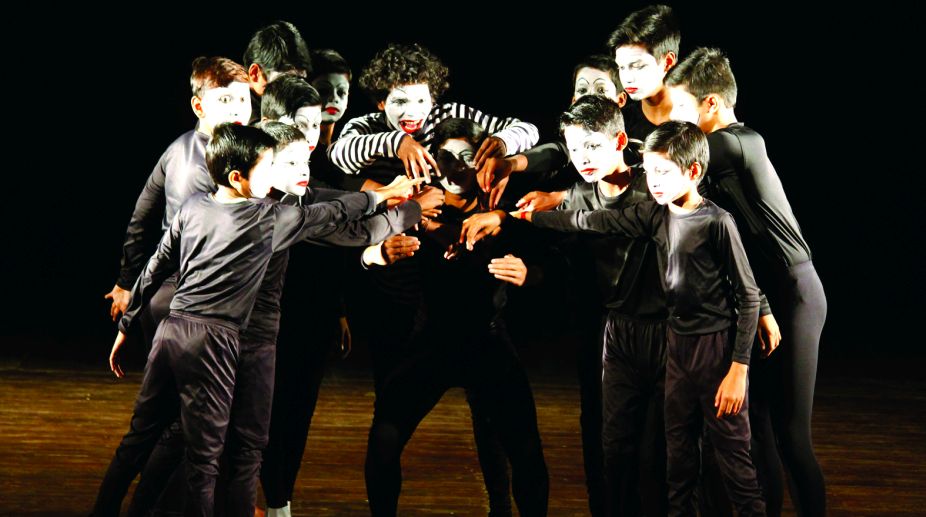There are a number of cultural festivals held all over the country presenting a variety of theatres. But the art of mime never gets priority in those fests.
Recently people were enthralled by the this art form of theatre at the four day National Cultural Festival organised by Rangtal Theatre (Halisahar) at Aikatan auditorium in Naihati.
Advertisement
Ratan Chakraborty, director of Rangtal theatre, has been a professional mime artiste for the last 27 years and founded this group to nurture this rare form of theatre. For the last seven years he has been organising this festival, inviting groups from different states to showcase the art form of mime and puppet along with normal theatre.
This year’s festival included Mime and Puppet shows and Theatre presentations from Bangladesh, Tripura, Madhya Pradesh (Bhopal) and different parts of West Bengal, including his own productions of Rangtal Theatre.
His mime shows, ‘Charley’s Love’ and ‘Palowan’, proved that even without speech the presentations can charm the viewers by facial expressions, body language, movements and activities which can be very engaging. In the former show, Charley’s love stole the heart of a girl (Tandra Chakraborty), but he finally lost the strength in the hands with which he had initially offered flowers to her. Ultimately, the girl herself offered the same flower to Charley’s inactive hands. Emotional incidents enacted with expertise gave evidence of powerful acting without the aid of words.
With similarly fine artistry, the show ‘Palowan’ established the truth that physical strength of the so-called palowans (thugs) is not the last word. Apparently, even a weak person can conquer the strong and as a result, his love gets accepted by the desired one. Through apt lighting, music and humorous situations, the presentation was noteworthy. Rakesh Saha, Rana Ghosh, Tandra Chakraborty and Ratan Chakraborty (the husband – wife duo) did justice to fulfill the demands of production.
Their students’ performance ‘Mulyabodh’ led by the little Trisha Chakraborty gave a message to keep the city clean, through comic scenes. Little Drama Group of Tripura (directed by Gautam Saha) presented the mime show ‘Bhoy’ (fear), which indicated that dishonest people are always afraid, but once they come out of their unfair practices, they can enjoy life. Very soothing western music played throughout the show maintained the spirit of the theme. Gautam Saha played the character of ‘Fear’.
Bangladesh’s (Gajipur, Dhaka) mime production ‘Death of Humanity’ by Mukta Mancha Nirbak Dal, directed by Shahidul Hasan Shamim had a unique blend of thought and technique. A blind man (portrayed by the director) gained his vision through prayer, yet he damaged his eyes with a knife upon witnessing the horrors of global brutality, which he was ignorant about earlier due to his blindness.
The rape scene, with red costumes and red hued lights, was conducted in an artistic manner. Pictures of global inhumanity, including the Rohingya problem, displayed on the background screen, enhanced the authenticity of the theme. At the end the blind person picked up the newborn child from the dustbin, whom the raped woman had left behind, establishing the victory of humanity.
As for the flute heavy soundtrack, the music gradually became louder to keep parity with the strong flavour of the subject.
The concluding day’s last presentation was a play named ‘Re-Phoolsajja’ by the group ‘Naihati Samay 1400’. It was a fully enjoyable comedy directed by Anup Biswas. Set in a police station, the reunion of a couple, who had divorced on the very night of phoolsajja, unfolded hilariously to the delight of the crowd. The set, costumes, props and music – all the aspects matched the jovial spirit of the production.
Two puppet shows (Rod Puppet) were also part of this festival. Tripura’s ‘Sita Aaj o Kaal’ showed the contrast between timid women of the past and today’s bold, independent women who have the strength to protest against mistreatment.
The Department of Culture, Govt. of India must be appreciated for concerted efforts to preserve and promote such uncommon and rare art forms.











